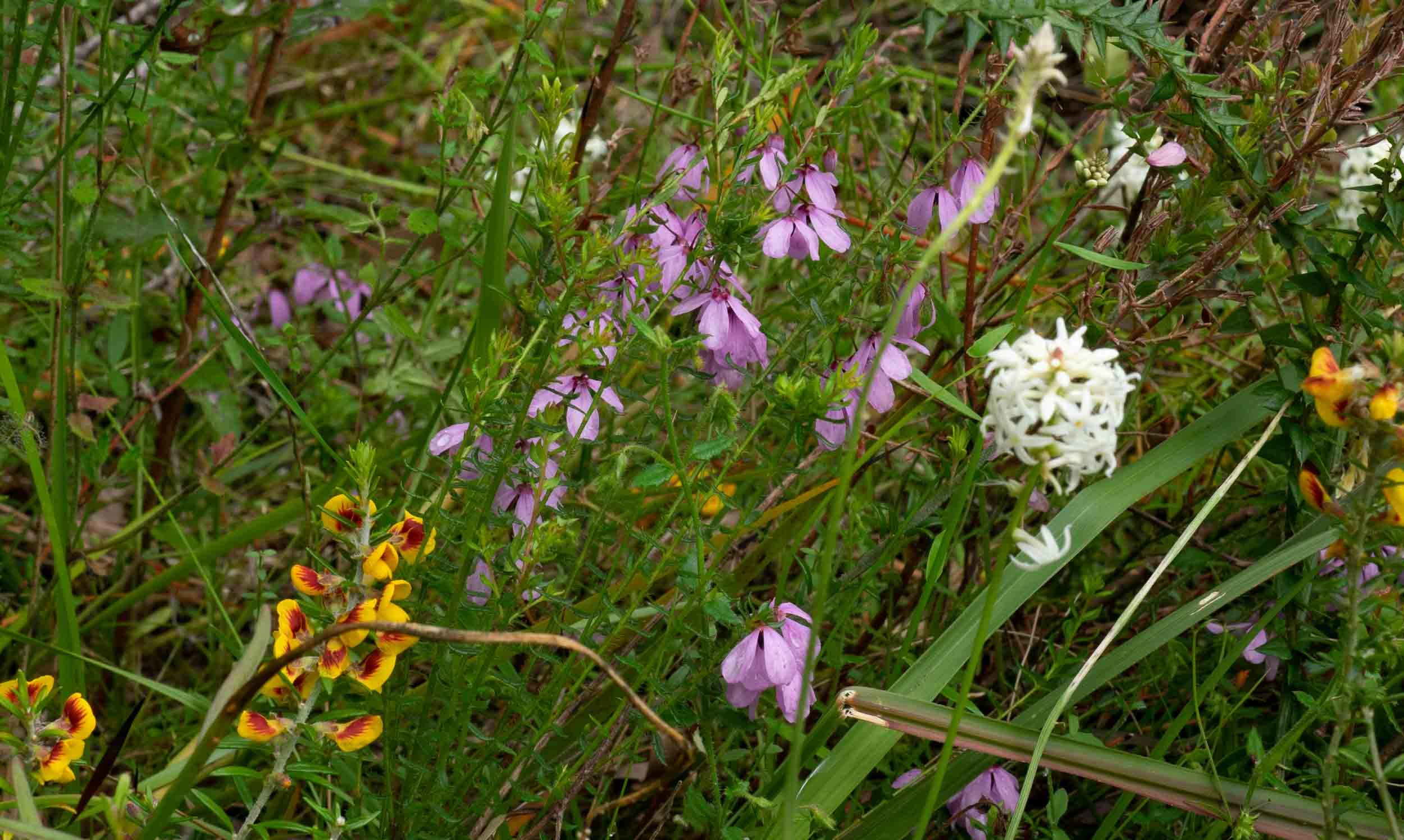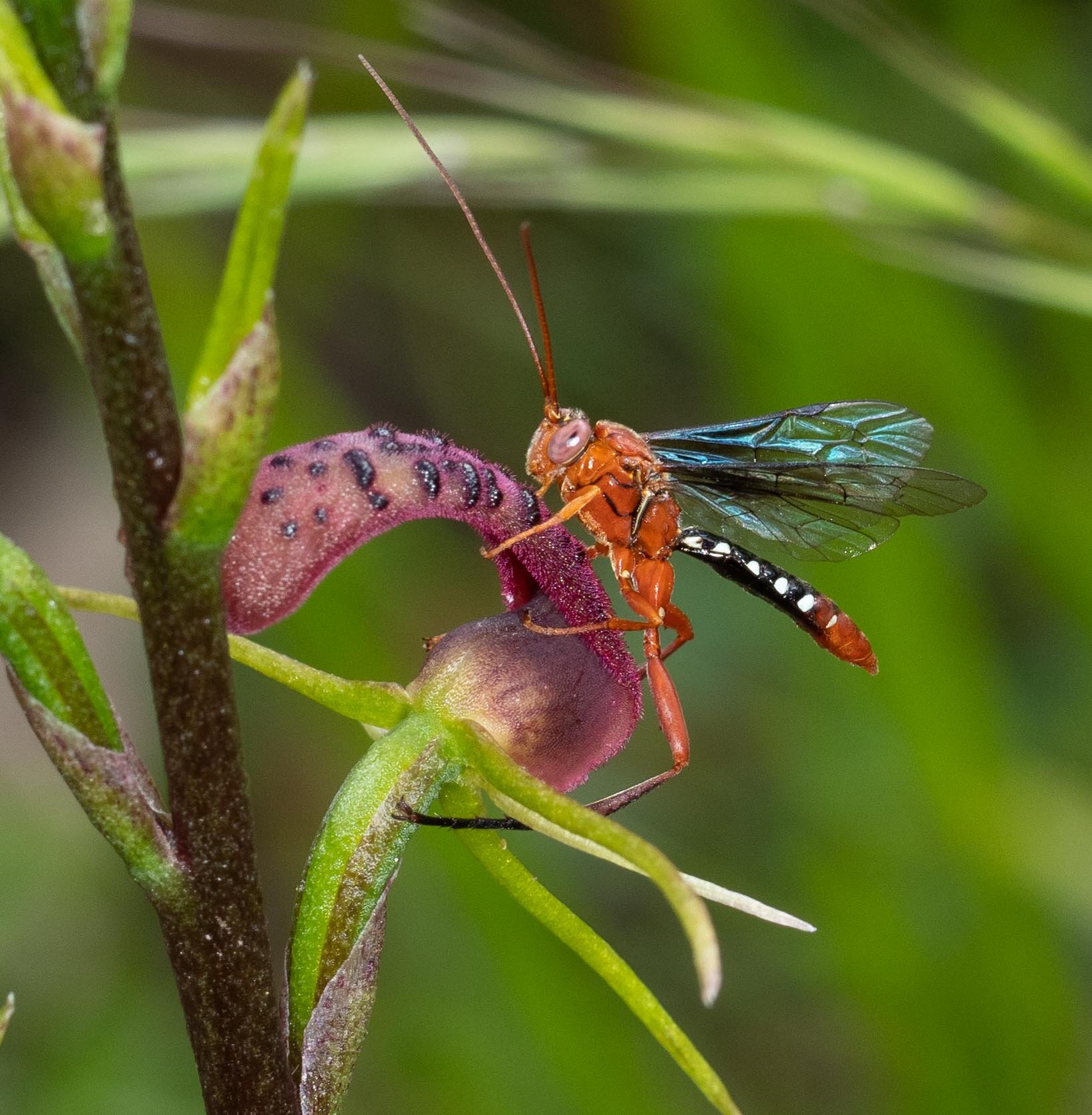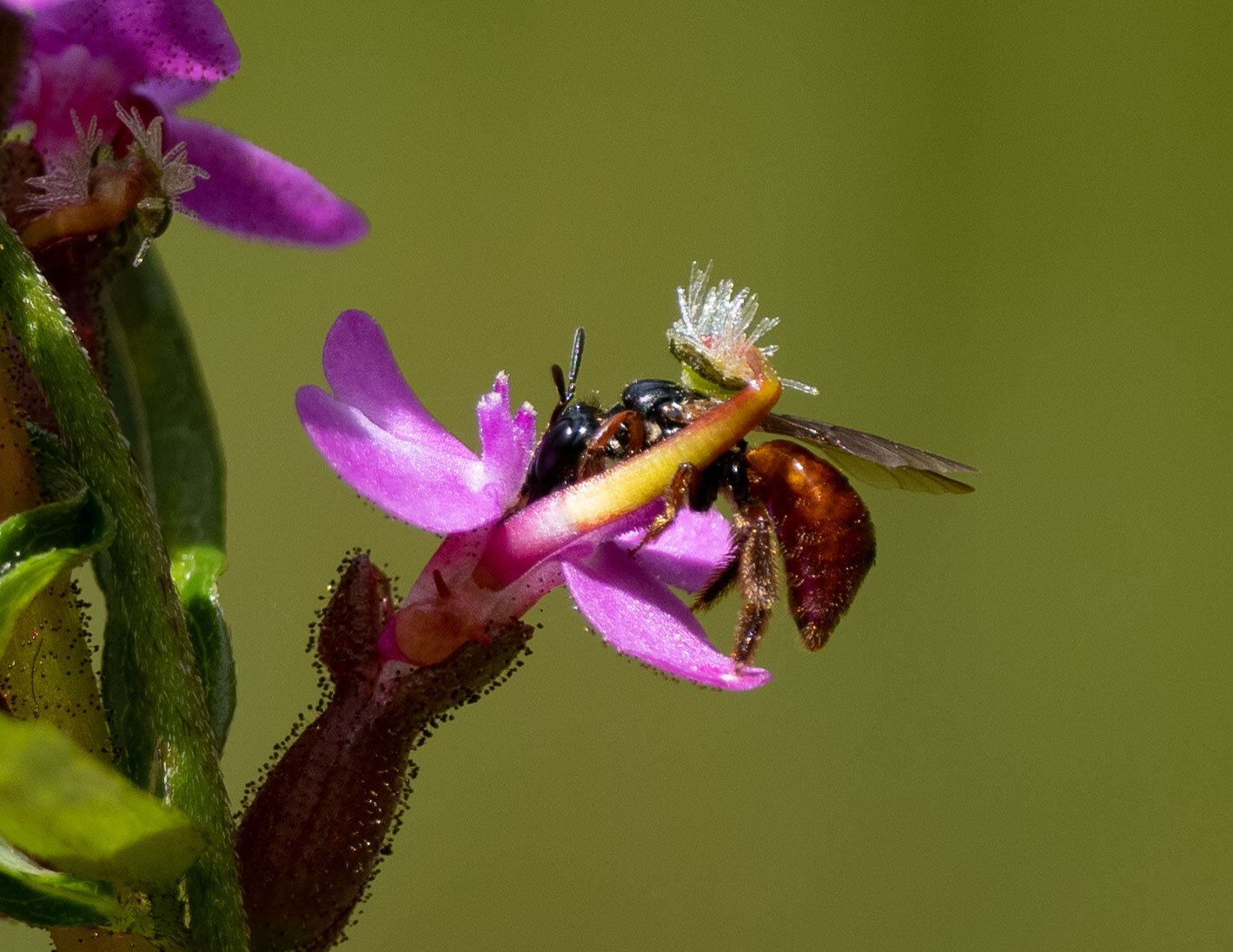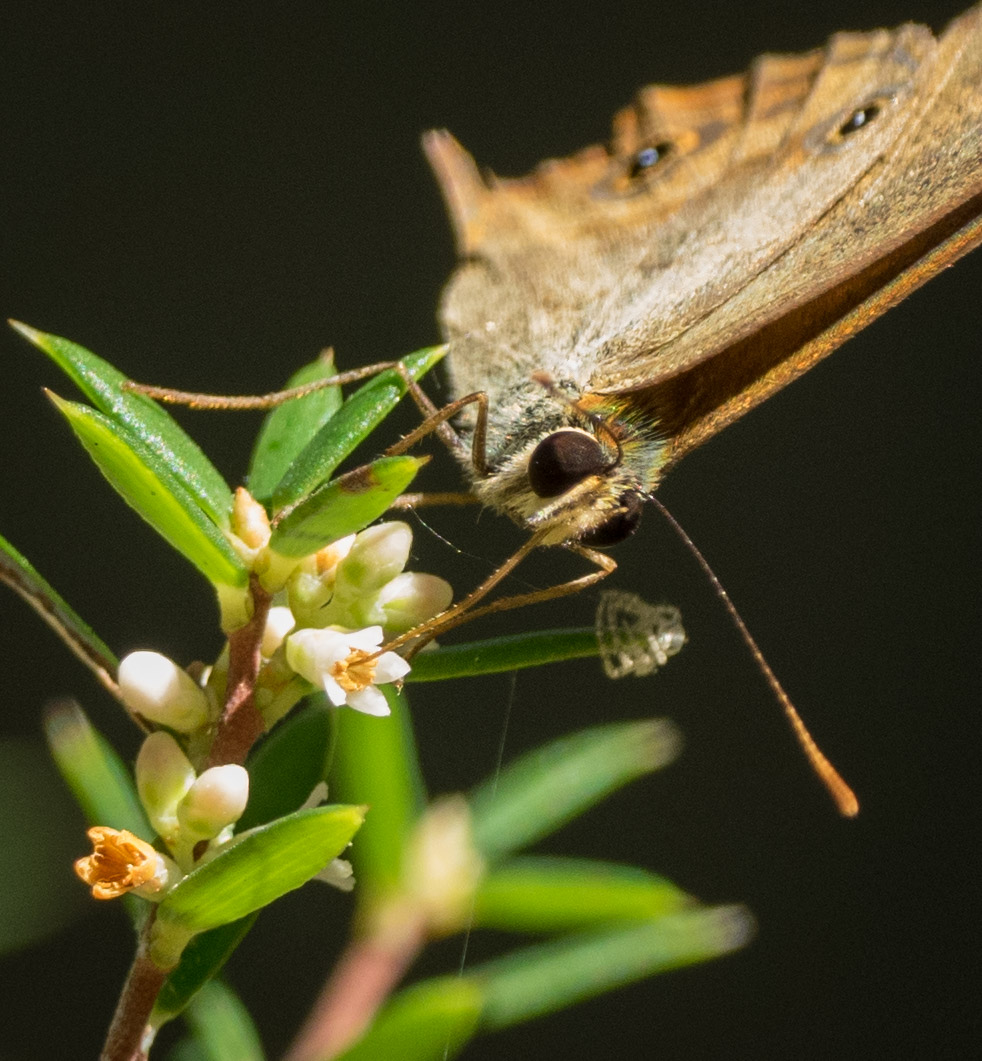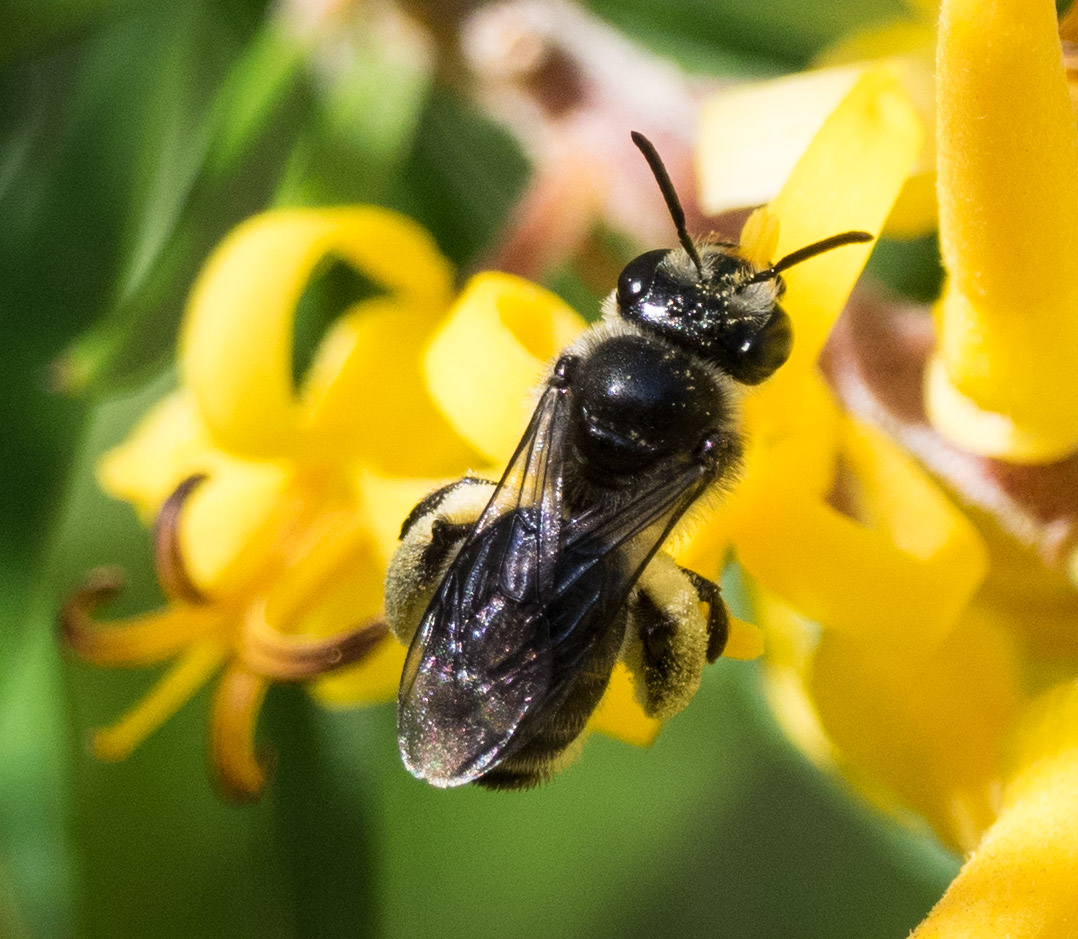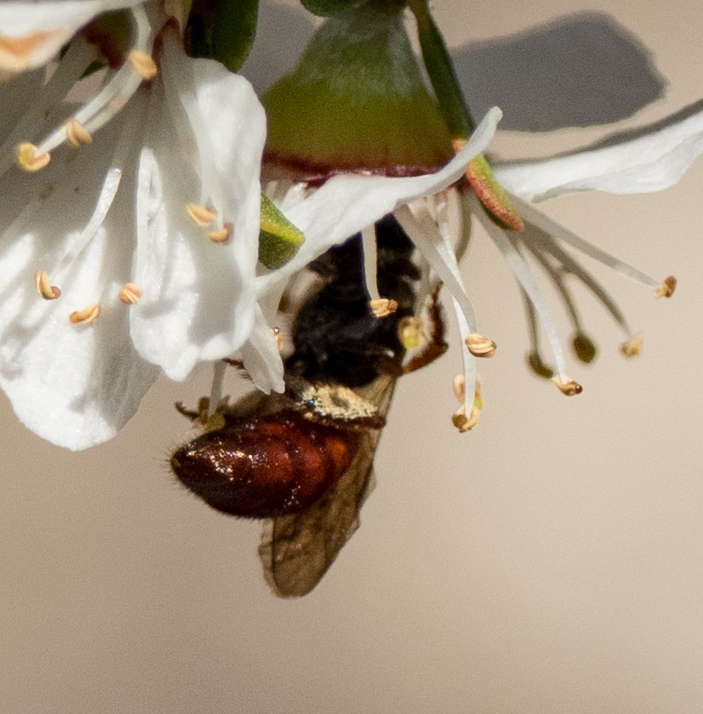One bush, many insects

The tea-tree flower ticks all the boxes for a nectar or pollen feeding insect.
It produces copious quantities of nectar in an accessible, large, shallow bowl. Its pollen-bearing anthers are conveniently placed on several vertical stalks around the rim of that bowl. And as a bonus, its five large, plate-like petals provide flat landing pads for an arriving insect.
Our Round Leaf Tea-tree (Leptospermum rotundifolium) bushes are currently flowering profusely. They are a visual treat, but what has really attracted our attention are the insect visitors to the blooms.
I’ve spent several hours watching and recording activity of insects and other arthropods on the flowers. Here are some snapshots of my observations.
Bees
The great majority of winged insects visiting the flowers are bees - almost all of which appear to be just one species.
These are moderately small bees, 5-6mm long and with prominent yellow spots on the sides of the abdomen. The tea-tree flowers are swarming with them at certain times of the day.
So what are these bees?
Its wing venation and head morphology suggest this bee belongs to the native bee genus, Euhesma, a member of the family Colletidae, the short-tongued bees.
Terry Houston (A Guide to Native Bees of Australia, CSIRO Publishing, 2018) states that Euhesma bees are generally fussy feeders - each species takes nectar and pollen from only a limited range of plants. He lists Leptospermum among the plants used by the Euhesma crabronica species-group, so this is a candidate for the bees I observed on our bushes.
I enjoyed watching these bees supporting themselves on the filaments of the stamens as they gathered pollen from anthers. They use brushes on the tarsi of their forelegs to sweep pollen into the mouth. I could often see other legs carrying pollen grains, in contact with the stigma. So the Euhesma bees clearly contribute to pollination of the tea-tree.
However, pollen sticks to the body hairs of this bee by accident, not by design. Colletid bees do not have the specialised groups of hairs (called scopae) on their hindlegs or abdomen, that most other bee families use to gather and transport pollen back to the nest.
Rather, they carry pollen in their crop, ingesting the pollen grains as they sweep them out of the anther.
Having taken a load of pollen, the bee transfers to the floral cup and sucks up some nectar with her tongue. I made this video of a Euhesma bee, showing her moving back and forth between the pollen and nectar sources.
The nectar collected by the bee is concentrated by a very neat trick, called “bubbling”, which Kerri has described in an earlier blog.
The female regurgitates nectar from its crop and holds a drop in her mouth for a few seconds. Evaporation of water makes honey!
The honey is then swallowed and passes back to the crop, where it mixes with the stored pollen to make a paste.
A Leioproctus bee demonstrates “bubbling”
Like almost all native bees and unlike the introduced honey bee, Euhesma bees live solitary lives. The female typically makes her nest in the soil. In the subfamily Euryglossinae, to which Euhesma belongs, a nest contains several brood cells, each housing a single larva (Houston, 2018). The cells lie in lateral burrows, radiating out from a vertical shaft, which can be over 10cm deep - an impressive engineering feat for such a small creature!
Having finished preparation of a brood cell, the female progressively adds aliquots of honey/pollen paste, regurgitating it from her crop after she returns from foraging expeditions. Finally, she lays an egg on top and seals the cell.
When the larva hatches from the egg, it will be sustained by this nutritious vegetarian - actually vegan - diet.
Other bees
I saw just two other bee species on the Leptospermum rotundifolium flowers. A couple of times this tiny bee made an appearance. It’s only about half the size of the Euhesma bee. No idea who it is.
This video shows it lapping up nectar from the floral cup.
On one, and only one occasion, I saw a Honey Bee Apis mellifera feeding on the tea-tree. The flower provides a useful sense of scale to appreciate how much larger this introduced species is than the Euhesma bee.
Other hymenopterans - ants and wasps
Without doubt, the most common insect on the tea-tree is a tiny ant - probably Iridomyrmex rufoniger, the Black Tyrant Ant. One or two are seen on virtually every flower. The ants appear oblivious to the Euhesma bees. The bees, on the other hand, often take flight when ants approach them.
A couple of times, I saw huge numbers of tiny insects flying around the tea-tree bush.
They never appeared to land, but I did manage to get a shot of one in flight to confirm it was an extremely small wasp.
At the other end of the scale, a rather large wasp - also unidentified, but some sort of flower wasp - made a fleeting appearance.
Flies
A wide range of flies - predators, pollen and nectar feeders - was seen on the tea-tree flowers.
Beetles
The diversity of beetles was also striking. Members of at least five different families - weevils, jewel beetles, flower chafers, clerid beetles and tumbling beetles - were seen.
Butterflies and Moths
Lilac Grass-skipper butterflies (Toxidia doubledayi) were mostly claiming territory by taking up positions at the ends of foliage or chasing away rivals. But on occasion they were seen sipping nectar.
Occasionally I saw the day-flying moth Amata nigriceps resting at the ends of branches. Its striking black and orange colouration warns a potential predator of its noxious taste.
Bugs
Just a couple of hemipterans made an appearance - the large and rather ungainly Broad-headed Bug and the much smaller Rutherglen Bug.
This video shows the Broad-headed Bug wandering over a flower before finally checking out the stigma. It looks like it is stealing pollen from its surface.
Spiders
Every ecosystem has its predators. I discovered a Bush Orb-weaver spider (Plebs eburnus) lurking in the foliage of the tea-tree bush. It had assembled an unobtrusive web and had succeeded in capturing a few tiny insects - perhaps those small wasps.
So there is a wealth of life on the Round leaf Tea-tree, taking advantage of the plant’s showy reproductive efforts.
Some of the insects will be fostering those efforts by pollinating its flowers. Others probably just steal pollen and nectar without giving anything in return.
But it all makes for a great show!


















































